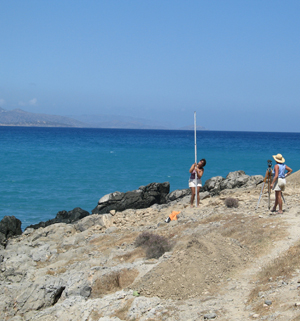
Exploration of the west-central portion of the Gulf of Mirabello coast, eastern Crete, began in 1910 and 1912 when Edith Hall of the University of Pennsylvania Museum began an excavation of the settlement and cemeteries of Vrokastro, a Bronze Age and Early Iron Age refuge settlement on a mountain peak near the coast. This excavation was followed in 1912 by a brief two-week excavation at the coastal site of Priniatikos Pyrgos, which revealed part of a large Early to Late Bronze Age harbor settlement on this small coastal promontory. The historical settlement of this coastal site was represented by abundant Roman pottery.
The Vrokastro Survey Project (Vrokastro Reports vols. 1-3, 2002-5) provided the framework for further exploration of this coastal ‘gateway’ community and emporium through analysis of the settlement systems and environment of the region, and the Istron Geoarchaeological Project (2002-6) has investigated the coastal environment of Priniatikos Pyrgos. Remote sensing conducted on the site indicated the presence of a well-preserved industrial area and settlement that spans millennia. Excavation of Priniatikos Pyrgos began in 2005, with the cooperation of the local Greek Department of Archaeology. Barbara J. Hayden, Senior Research Scientist in the Mediterranean Section of the University of Pennsylvania Museum, is directing this excavation. This project includes exploration of the history, trade networks, regional significance, and manufacturing base of this primary coastal site.
Excavation in 2005 revealed the presence of two Bronze Age pottery kilns and evidence for metalworking and ceramic and glass production in the Greek and Roman periods; a Minoan workshop area; and part of an extensive Greek and Roman/Byzantine settlement built over earlier well-preserved Bronze Age structures. The distribution of ceramics manufactured at this site can be documented through the presence of a rock temper (granodiorite) in the clay, this derived from the unique geology of the region. This ‘signature’ in the clay of vases manufactured at the site makes it possible to reconstruct the development and extent of maritime trade from Priniatikos Pyrgos in the prehistoric and historical periods.
Exploration of Priniatikos Pyrgos, the primary coastal settlement and industrial site of the west-central Gulf of Mirabello region, will result in a deeper understanding of prehistoric and historical periods in eastern Crete and interaction with other regions of Crete and the Aegean. This will be accompanied by new data concerning the development of technologies and their economic and political implications for eastern Crete and the southeastern Mediterranean.
